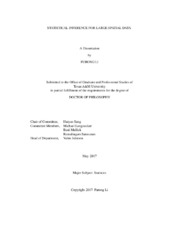| dc.description.abstract | The availability of large spatial and spatial-temporal data geocoded at accurate locations has fueled increasing interest in spatial modeling and analysis. In this dissertation, we present one study concerning the inference on properties of a single spatial process, and then turn to multiple processes and provide two modeling approaches exploring the spatially varying relationship between covariates and the response variable of interest. In the first study, we investigate the inference tool based on quasi-likelihood, composite likelihood (CL) method and propose a new weighting scheme to construct a CL for the inference of spatial Gaussian process models. This weight function approximates the optimal weight derived from the theory of estimating equations. It combines block-diagonal approximation and tapering strategy to facilitate computations. Gains in statistical and computational efficiency over existing CL methods are illustrated through simulation studies.
The second investigation is the development of a new spatial modeling framework to capture the spatial structure, especially clustered structure in the relationship between response variable and explanatory variables. The proposed method, called Spatially Clustered Coefficient(SCC) regression, results in estimators of varying coefficients, which conveys important information about the changing pattern of the relationship. The SCC method works very effectively in estimation for data either with clustered coefficients or smoothly-varying coefficients, based on our simulation results. Thus, it allows the researchers to explore the spatial structure in the regression coefficient without any priori information. We also derive some oracle inequalities, which provides non-asymptotic error bounds on estimators and predictors. An application of the SCC method to temperature and salinity data in the Atlantic basin is provided for illustration.
Motivated by the studies in Geoscience that the influence of turbulent heat flux on sea surface temperature (SST) varies at different spatial scales, we develop a statistical model to quantify the continuous dependence of SST-turbulent heat flux relationship (T-Q relationship) on spatial scales. In particular, we propose a penalized regression model in the spectral domain to estimate the changing relationship with spatial scales. While application to T-Q relationship is the main motivation for this work, it should be emphasized that the penalized spectral regression framework is general and thus is applicable to other phenomena of interest as well. | en |


